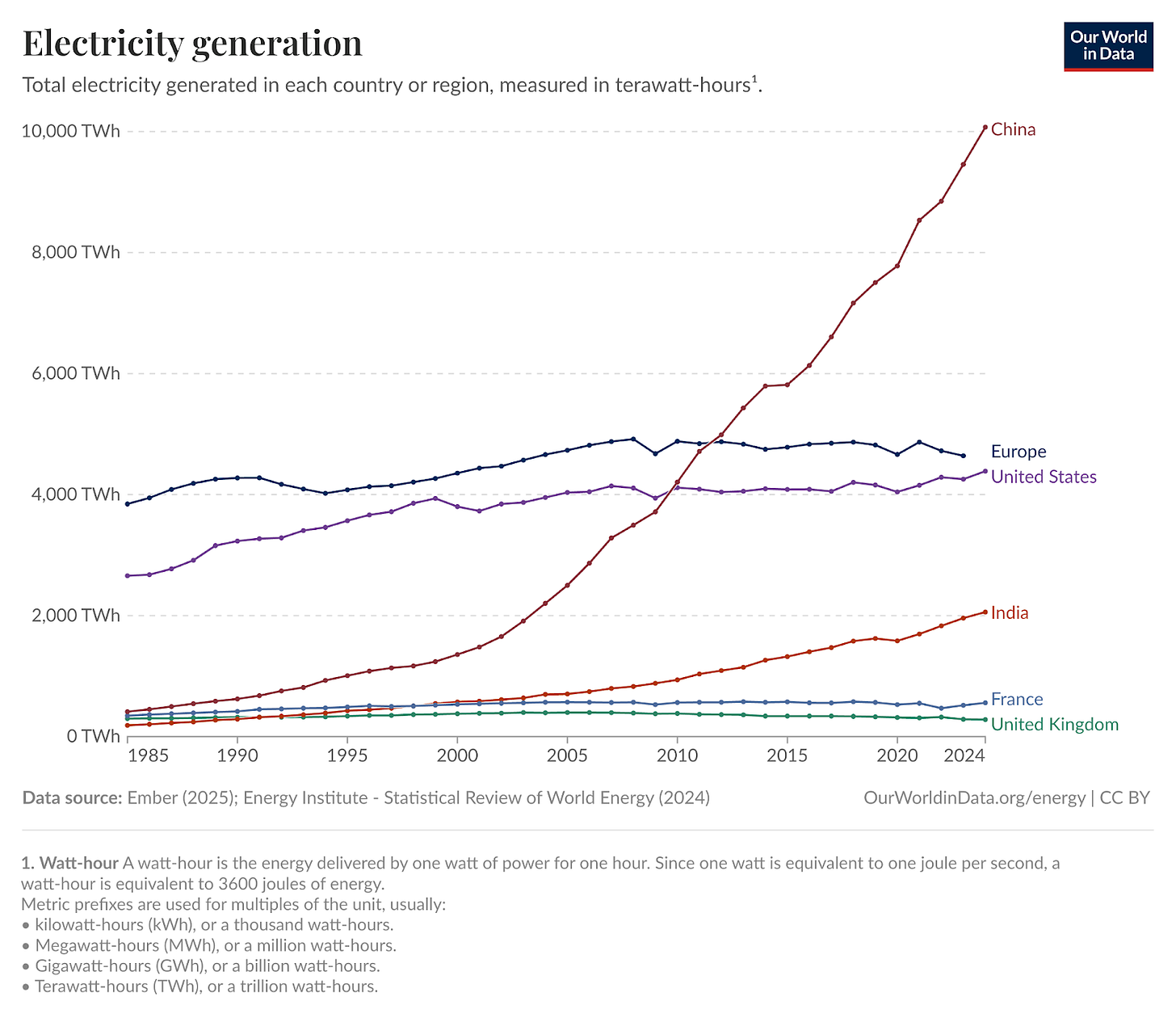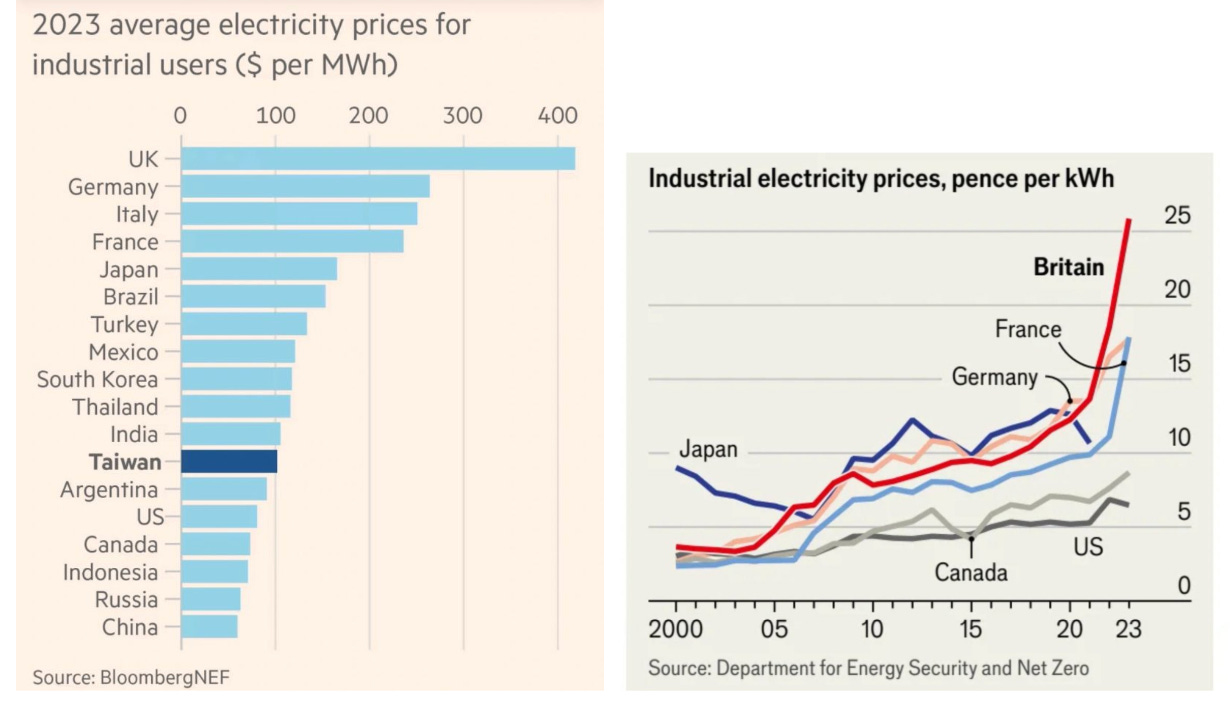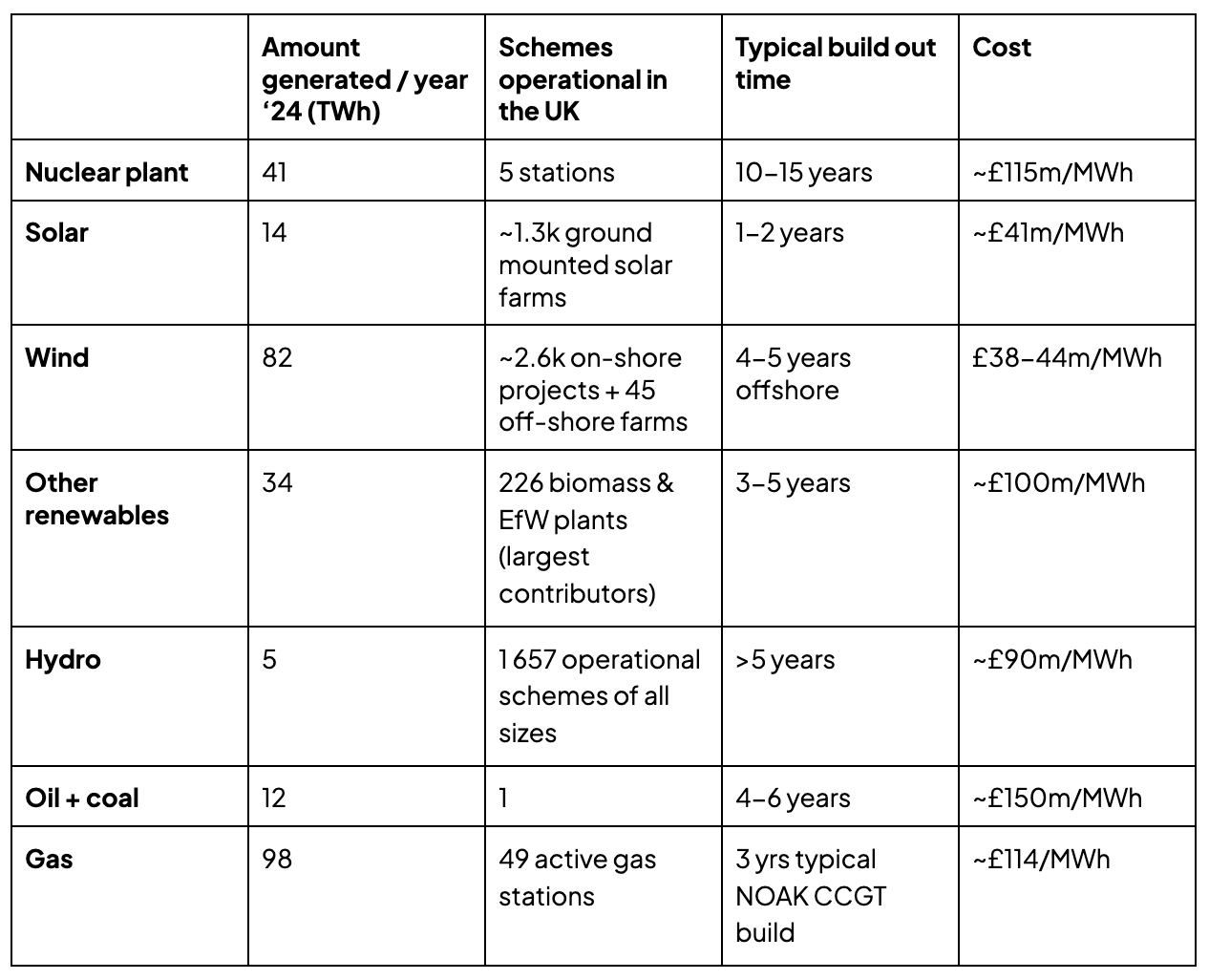The Energy Theory of Everything
We need abundant energy to unlock Britain’s next industrial era.
A thought experiment: If you were forced to collapse all growth related policy objectives down into a single lever, what would you choose?
I’ve debated this a few times recently and have always thought the right answer is the cost and availability of energy, and electricity more specifically. But i’ve failed to explain exactly why I think that in a coherent way, so this is my rough attempt to do so.
This might seem like a trivial exercise when clearly policy makers in government don’t just care about one thing. But so much of the policy output today is an assortment of small interventions. All perfectly reasonable, but so watered down in terms of scale, they will only ever have the most marginal impact.
You may also be thinking this is a bit late given the UK’s industrial strategy published just last month attempted to do something about energy prices. While credit should go to the team for going after it .. of course from the outside i’m bound to say it didn’t go far enough. What if all the funding in the strategy across the hodgepodge of small ideas went into this one objective instead?
My rough logic is as follows…
Everything is downstream of energy
Electricity is the master input: everything is downstream from it. When energy is cheap, the cost of making, moving, and thinking all fall in tandem. Manufacturing becomes more competitive, entire industries reorient toward regions where power is abundant and low-cost, and households benefit too. Cheap electricity doesn’t just reduce bills, it reorganises economies. It attracts factories, infrastructure, and capital. It sets the floor for productivity and the ceiling for ambition. If you want faster growth, cheaper power is the most reliable place to start.
UK energy production has fallen
Electricity production has fallen sharply in the UK since 2000 (even when you take into account net imports). Just looking at domestic production the story is even worse.
And we’re only going to fall further behind if the trends in these charts continue (although the US is doing its best not to move further ahead right now with The One Big Beautiful Bill Act, which guts the tax credits for wind and solar projects that were included in Biden’s Inflation Reduction Act).
Energy = productivity
Basic economics tells us that output is a function of labour, capital and TFP (ie productivity or tech progress). Energy is a core part of this: cross-country evidence from the OECD shows that a 5% rise in energy prices reduces productivity by ~0.4% in the following year. In other words, when energy gets expensive, economies get less productive.
Relative prices = industrial competitiveness
In the UK, industrial electricity prices averaged >$400/MWh in 2023, over 4 times the rates in the US. This gap isn’t trivial, it shapes where companies locate, invest, and hire. It’s also not always been the case - in 2000 we were effectively comparable to other major economies. A single “one-price” national market also masks large regional differences between e.g. cheap wind in Scotland vs peak demand in the south-east, which we don’t allow companies to take advantage of.
These price differentials wipe out wafer-thin steel and battery margins and explains why the next gigafactory breaks ground in Nevada, not Teesside. This isn’t just theory: you can see it everywhere. Factories are shutting as a direct result of high energy prices. Across energy intensive sectors like heavy industry, computing and chemicals, the cost of electricity is the prime strategic input.
It’s worth noting that Germany and South Korea show you can run world-class manufacturing with higher power costs – but their delivered prices are still 20–40 % lower than ours and both cushion electro-intensive exporters with network-fee rebates.
Intelligence is a function of electricity
AI turns energy into intelligence. 0.3 Wh is the electricity cost of a single GPT-4o query. Now imagine an AI agent that fires 100 calls per task, with a power user running 100 tasks daily. That is 3 kWh per user per day. Scale to one million users and the total hits 1.1 TWh a year – Oxfordshire’s household demand – before you even count model-training. The IEA expects global data-centre demand to double to 945 TWh by 2030 even taking into account potential hardware efficiency gains.
Electricity now absorbs ~42% of a hyperscale facility’s annual operating budget, dwarfing hardware and labour. Within that, servers guzzle ~45% of the electrons while cooling systems can swallow another 40-50%. No wonder Microsoft is spending £63bn on Nordic campuses anchored by sub-€40/MWh wind-and-hydro contracts. Other AI giants are following suit: Google is ordering six SMRs from Kairos, running data centres on Fervo’s geothermal power and has signed up to buy power from a Nuclear Fusion plant that doesn’t exist yet, while Amazon is co-developing four SMRs with X-energy.
Data centres are critical national infrastructure
One argument is that there is a global market for compute and it doesn’t matter where these data centres are located.
But when most of what is today called white collar work is done by AI, would a state want this capability to be turned off? That is where we are today. The UK has almost no sovereign compute capacity.
Thankfully, this has been recognised and some great work has been kicked off by the recently established Sovereign AI Unit. But in truth, all they can do is throw some subsidies at the problem - for the UK to build any real capacity, we need to be price competitive...
Green energy ≠ expensive energy
If renewables and nuclear can provide reliable baseload power cheaply, we get both climate gains and growth dividends. This is already happening:
Wind and solar now supply over 30% of UK electricity, up from just 3% in 2010.
Small modular reactors (SMRs) are being fast-tracked in the UK and US to deliver nuclear baseload at lower cost.
Grid-scale batteries are coming online to stabilise intermittent supply.
This isn’t just climate policy. It’s growth policy. And we have now decoupled emissions from growth:
Energy abundance means policy optionality: the bottleneck on ambition is energy
Cheap energy subsidises everything:
Housing construction (steel, cement, transport)
Public services (hospital heating, school lighting)
Public transport (electrified rail, buses)
Food (fertiliser, refrigeration, processing)
It gives governments fiscal room by lowering costs and stimulating growth.
What stops us from building a high-speed rail network across the UK? Or running 24/7 vertical farms? Or rolling out district heating at scale? Not labour or capital, but energy.
According to UK National Grid forecasts, electrification of transport and heat could raise national electricity demand by 50–70% by 2040. That’s without AI training and inference loads. Without doubling supply and cutting cost, like so many ideas, these will never get out of the planning stage.
If the policy goal is growth, jobs, productivity, reindustrialisation, resilience, climate transition, or geopolitical autonomy — all paths need more electricity.
Lower the cost of energy, and you expand the feasible frontier of policy.
Ok so maybe you buy it. How much energy do we need by, say 2040? This is extremely back of an envelope, but to give a sense of scale.
Electric vehicles → estimates suggest about 70 TWh more
Heat pumps / electric heat → to hit CCC balanced pathway ~50 TWh more
Electrolytic hydrogen → ~4 GW of electrolysers is ~15 TWh
Data centres / AI inference → wide range of estimates .. but around ~40 TWh on the lower end
That’s pretty much just to meet demand in line with climate targets, rather than thinking about abundance. And it means a 175 TWh increase from today, which stands at around 310 TWh.
But at 485 TWh, that would still leave us miles behind even France, with over 550 TWh’s of production in 2024. So if relative production and price is actually important, maybe we should really be aiming for closer to 600, which would be roughly doubling today’s production.
Is it remotely possible? Clearly it’s a big ask .. and others far better placed to make proposals. So again, back of an envelope…
Let’s assume we’re trying to get there via increases in nuclear, solar, wind and renewables, rather than more gas imports, or north sea oil. It would mean something like:
Triple nuclear production to 120 TWh. That might sound infeasible, but France produced 379 TWh from nuclear power in 2024: it is about policy choices. Sizewell c is due to have around 25 TWh capacity. So we need another 2-3 of these started asap given long build times.
Triple wind farm production to 240 TWh
5x solar to 75 TWh
Double other renewables to 70 TWh
There’s obviously a wider set of things we could do too, like invest massively in fusion research, storage capacity, carbon capture and remove some of the levies on power bills (a good explainer on this by the head of the CCC here), which make our electricity prices even more expensive than they would otherwise be.
And there is so much nuance in this I brush over absurdly, like the infrastructure requirements, grid updates, planning changes, and supply chain constraints for inputs that we don’t control e.g. materials or magnets. And how we find the hundreds of £bns to pay for all this (and will make people in govt roll their eyes at this piece in general), which needs a longer piece on its own.
Or why generation alone isn’t likely to be enough and we may also need a market that prices by time and place e.g. by shifting to locational marginal pricing (LMP) and using two-way CfDs.
But for now, the core point i’m trying to land is that energy is the building block for so much of what drives growth, we should be singularly focussed on it. And build a narrative around why policy makers from all sides, as well as founders and investors, should make it a core priority over the next decade and beyond.
Thanks for reading - please do get in touch or leave a comment!









This is a really interesting article Jonno - the hill that needs to be climbed is very steep but we’ve come a long way already. One key policy lever that needs a good yank is to move many of the levies on electricity on to gas to incentivise electrification. Heat pumps etc will never grow to where we need them to be without closing the “spark gap” with gas.
Unsure we’ll ever need 4GW of Electrolytic Hydrogen capacity, as per your estimates😬 every kWh of electrolytic that goes towards H2 production would be better used directly as electrons wherever possible…
Thanks for the article!